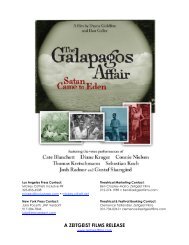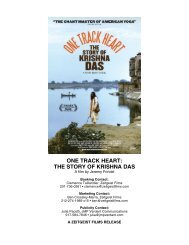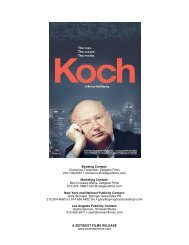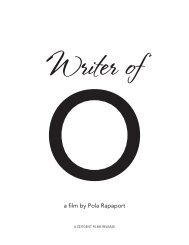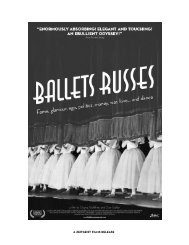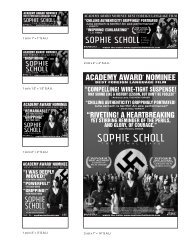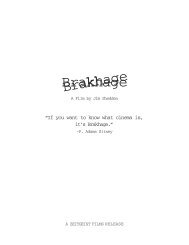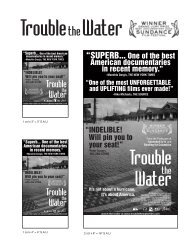Caravaggio Derek Jarman's - Zeitgeist Films.
Caravaggio Derek Jarman's - Zeitgeist Films.
Caravaggio Derek Jarman's - Zeitgeist Films.
Create successful ePaper yourself
Turn your PDF publications into a flip-book with our unique Google optimized e-Paper software.
<strong>Caravaggio</strong><br />
<strong>Derek</strong> Jarman’s<br />
A ZEITGEIST FILMS RELEASE
<strong>Caravaggio</strong><br />
<strong>Derek</strong> Jarman’s<br />
<strong>Caravaggio</strong> is probably the closest <strong>Derek</strong> Jarman ever came to making a<br />
mainstream film. As it reveals the seventeenth-century painter’s complex<br />
life—his brilliant, nearly blasphemous paintings and flirtations with the<br />
underworld—it is also a uniquely complex and lucid treatment of Jarman’s<br />
major concerns: violence, history, homosexuality, and the relationship<br />
between film and painting. <strong>Caravaggio</strong> incorporates the painter’s precise<br />
aesthetic into the movie’s own visuals and uses the style and mood of his<br />
paintings to reflect his life. The result is Jarman’s most profound,<br />
unsettling and astonishing reflection on art, sexuality and identity.
SYNOPSIS<br />
Painter MICHELANGELO MERISI (Nigel Terry), born at <strong>Caravaggio</strong> near Milan in<br />
1571, lies on his deathbed in a simple room in Porto Ercole, Tuscany. He is in<br />
his fortieth year; his face bears savage scars. He has been on the run for years<br />
and is dying far from home. It is a miserable death for an artist of stature. What has<br />
brought him here?<br />
After serving an apprenticeship to a painter as a boy, the young MICHELE<br />
CARAVAGGIO (Dexter Fletcher) moves to rome, where he struggles to live by selling<br />
his paintings on the streets. Ill from poverty, <strong>Caravaggio</strong> paints himself as Bacchus. He<br />
is visited in hospital by CARDINAL DEL MONTE (Michael Gough), an art lover who is<br />
intrigued by this painting. The Cardinal gives him room and board in his palace in return<br />
for his services. Under Del Monte’s patronage he continues his education and wins his<br />
first major public commission for the French church of St. Louis in Rome: The Calling of<br />
St. Matthew and The Saint’s Martyrdom.<br />
Executing the work is causing <strong>Caravaggio</strong> great trouble until, in a tavern he frequents,<br />
his attention is drawn to RANUCCIO THOMASONI (Sean Bean), a young gambler on<br />
the make. Ranuccio, to whom <strong>Caravaggio</strong> is attracted, joins the painter’s band of low-life<br />
models as St. Matthew’s killer, and the paintings progress. <strong>Caravaggio</strong> also paints<br />
Ranuccio’s woman, the beautiful prostitute LENA (Tilda Swinton). A knife fight erupts<br />
between <strong>Caravaggio</strong> and Ranuccio over a bet and <strong>Caravaggio</strong> is wounded. The<br />
developing triangular relationship between the two men and Lena deepens.<br />
MARCHESE VINCENZO GIUSTINIANI (Nigel Davenport), a prominent banker who has<br />
rescued <strong>Caravaggio</strong> from the outcry caused by one of his St. Matthew paintings by<br />
taking it for himself, commissions <strong>Caravaggio</strong> to paint Eros (or Profane Love) from life.<br />
<strong>Caravaggio</strong> invites both Ranuccio and Lena to Giustiniani’s fashionable unveiling party.<br />
Amid the decadent glitterati of Rome, Lena is introduced to CARDINAL SCIPIONE<br />
BORGHESE (Robbie Coltrane), nephew of the Pope and the most powerful political<br />
figure in Rome. Borghese is impressed. Away from the crowd, BAGLIONE (Jonathon<br />
Hyde), a rival painter, concocts slander about <strong>Caravaggio</strong>’s depravity.<br />
Tragedy looms when <strong>Caravaggio</strong> paints Lena as the Magdalen. While posing, she<br />
reveals the extent of her scheming to ensnare Borghese and leaves Ranuccio and<br />
<strong>Caravaggio</strong> to each other. Later Lena is found drowned in the Tiber. Ranuccio is<br />
arrested for her murder and, protesting his own innocence, blames Borghese. While<br />
Ranuccio is in jail, <strong>Caravaggio</strong> drinks in the tavern. On his release, Ranuccio greets<br />
<strong>Caravaggio</strong> with a terrible revelation of guilt and is stabbed by his lover.
<strong>Caravaggio</strong> and DEREK JARMAN<br />
In some ways, Jarman’s CARAVAGGIO is as much about the artist <strong>Derek</strong> Jarman<br />
as the early seventeenth century painter who was so influential yet so<br />
scandalized his contemporaries with both the controversial nature of his art and<br />
his resistance to the social mores of his time. Having worked on various draft scripts for<br />
several years together with Nicholas Ward-Jackson, friend and art dealer, whose idea<br />
the project had originally been, Jarman found that he had begun to work elements of<br />
his own life into the script. At the same time, his interest and experience in filmmaking<br />
had been developing during this period and <strong>Caravaggio</strong>’s revolutionary use of light and<br />
dark (‘chiaroscuro’) made him a highly appropriate subject for a film. <strong>Caravaggio</strong> could<br />
indeed be described in retrospect as the inventor of cinematic lighting. It was the first<br />
time that dramatic ligjhting had been used in painting although now, of course, it is a<br />
central concern of every cameraman and filmmaker.<br />
Marginalized by the society in which he lived, the story of an artist whose life has only<br />
really been ‘rehabilitated’ over the past twenty to thirty years (through the ability to talk<br />
openly about his probably homosexuality) held an irresistable fascination for Jarman.<br />
On the evidence of his paintings alone, most modern critics would agree that<br />
<strong>Caravaggio</strong>’s homosexuality, with its accompanying sense of guilt and isolation, was<br />
central to his life and art. His life was more akin to Genet and Pasolini than to a<br />
picaresque Renaissance painter such as Cellini.<br />
<strong>Caravaggio</strong> was a poet of the low-life. While his paintings reflected an increasingly<br />
profound and original religious awareness, his private life was fraught with brawls,<br />
duels, arrests and even a libel case, culminating in 1606 in murder. This polarity was<br />
paralleled particularly in his religious paintings by the depiction of sacred figures using<br />
prostitutes, pimps and street urchins as models. Several altarpieces originally<br />
commissioned by the clergy were rejected on the grounds of impropriety. The tradition<br />
of the time was to paint abstracted and idealized figures and <strong>Caravaggio</strong>’s dynamic<br />
‘realism’ was considered scandalous. Yet, ironically, these paintings were eagerly<br />
snapped up by the most influential Italian patrons. Once he had been accepted into<br />
their world, he was fiercely protected, even after being found guilty of murder, by the<br />
most powerful figures of our time.
<strong>Caravaggio</strong> (1571-1610)<br />
Michaelangelo Merisi da <strong>Caravaggio</strong>, born in 1571 the son of a mason, is now<br />
considered to be the last great artist of the Italian Renaissance. He was<br />
taught by a minor Milanese painter, Peterzano, and when he was about<br />
nineteen made for Rome. Assistant to the artist Cavaliere Cesare d’Arpino, his first<br />
patron was the Cardinal del Monte who employed him to paint genre pieces like “The<br />
Lute Player”, and later won him the commission for his first large public religious<br />
paintings.<br />
Pioneer of a painting style using theatrical light, known as chiaroscuro, his style<br />
influenced artists as far afield as Rubens, Rembrandt and Velasquez. In 1606 he<br />
murdered a friend in a knife-fight and fled to Naples and Malta. He eventually settled in<br />
Naples and powerful friends, having obtained a pardon for the murder he had<br />
committed, made plans for him to return to Rome. However, the boat left without him as<br />
he was arrested, mistaken for a bandit. Destitute and despairing, he ran along the<br />
beach at Porto Ercole after his belongings which had sailed in the boat while he was in<br />
jail. He collapsed and died of a raging fever, brought on by heat and hunger, in 1610,<br />
when he was forty.<br />
Paintings referred to and/or re-created in the film:<br />
BOY WITH A BASKET OF FRUIT, Galleria Borghese<br />
THE SICK BACCHUS, Galleria Borghese<br />
THE LUTE PLAYER, Hermitage, Leningrad<br />
CONCERT OF YOUTHS, Metropolitan Museum, New York<br />
THE MARTYRDOM OF ST. MATTHEW, Contarelli Chapel, S. Luigi dei Francesi<br />
THE REPENTANT MAGDALEN, Galleria Doria-Pamphilj<br />
DEATH OF THE VIRGIN, Louvre, Paris<br />
THE DEPOSITION, Vatican Museum<br />
HEAD OF MEDUSA, Uffizi, Florence<br />
NARCISSUS (attributed), Galleria Corsini<br />
DAVID WITH THE HEAD OF GOLIATH, Galleria Borghese<br />
ST. JEROME IN HIS STUDY, Galleria Borghese<br />
PROFANE LOVE, Berlin, Staatliche Museum<br />
DOUBTING THOMAS, Potsdam, Staatliche Schlosser und Garten
DEREK JARMAN (1942-1994)<br />
<strong>Derek</strong> Jarman, arguably Britain’s most visionary filmmaker since Michael Powell, reinvented himself as<br />
often as Picasso. Equally at home making slyly subversive costume dramas or dreamy experimental cinepoems,<br />
Jarman was a bracing antidote to the Masterpiece Theaterization of British cinema, and, as the<br />
world’s leading gay filmmaker of his day, was an inspiration to a generation.<br />
Born in 1942, Jarman studied painting at the Slade School in London. His interest in costume and set<br />
design took him first to the Royal Ballet and then to the Coliseum in 1968 to work on a production of DON<br />
GIOVANNI. His first work in film was as the production designer on Ken Russell’s THE DEVILS in 1970.<br />
<strong>Derek</strong> Jarman’s first feature, SEBASTIANE, was made in 1975 and was followed by JUBILEE, which was<br />
screened at the Cannes Film Festival in 1977. His third film, an idiosyncratic adaptation of Shakespeare’s<br />
THE TEMPEST, was shown at the Berlin Film Festival in 1979. In 1980r he made several short films<br />
including his first pop promo, with Marianne Faithful. In 1984 the Institute of Contemporary Arts in London<br />
held a retrospective of Jarman’s paintings and in the same year he made a short film inspired by a trip to<br />
the Soviet Union entitled IMAGINING OCTOBER. He also completed designs for a ballet by Micha<br />
Bergese and published his first book, the autobiographical DANCING LEDGE.<br />
In 1986 CARAVAGGIO premiered at the Berlin Film Festival. This was a project which had taken Jarman<br />
seven years to realize but which finally was to gain him major recognition in the United States as a major<br />
innovative filmmaker. In the following year THE LAST OF ENGLAND was realized with a book of the<br />
same name. The film won an L.A. Critics Award. In 1988 Jarman directed WAR REQUIEM, based on<br />
Benjamin Britten’s work and featuring the last screen appearance of Laurence Olivier.<br />
Jarman directed the stage show of The Pet Shop Boys World Tour in 1989. The following year saw the<br />
production of THE GARDEN, the making of which is chronicled in MODERN NATURE, a collection of<br />
Jarman’s journals which also begins to record his personal struggle against the effects of the AIDS virus.<br />
However, this was not to hinder his work and, in an astounding burst of energy, Jarman made three more<br />
films in the next three years: EDWARD II (1991), WITTGENSTEIN (1992), and BLUE (1993). His final,<br />
and most challenging cinematic statement, BLUE screened at the 1993 New York Film Festival in<br />
November where Jarman received a standing ovation.<br />
<strong>Derek</strong> Jarman died of complications from AIDS on February 19, 1994.<br />
Feature Filmography<br />
1976 SEBASTIANE<br />
1977 JUBILEE<br />
1979 THE TEMPEST<br />
1985 THE ANGELIC CONVERSATION<br />
1986 CARAVAGGIO<br />
1987 THE LAST OF ENGLAND<br />
1989 THE WAR REQUIEM<br />
1990 THE GARDEN<br />
1991 EDWARD II<br />
1992 WITTGENSTEIN<br />
1993 BLUE
Nigel Terry (<strong>Caravaggio</strong>)<br />
This actor of stage and screen has devoted himself largely to period roles. He has<br />
appeared in his native England with the Royal Shakespearean Company, the Round<br />
House Theatre and the Royal Court Theatre. He made his film debut as Prince John in<br />
THE LION IN WINTER (1968) but did not appear onscreen again for thirteen years. His<br />
comeback was as King Arthur in John Boorman’s EXCALIBUR (1981). Terry teamed up<br />
with <strong>Derek</strong> Jarman for the first time in CARAVAGGIO, and subsequently in THE LAST OF<br />
ENGLAND, WAR REQUIEM, EDWARD II and BLUE. Terry is a familiar face on British TV<br />
and is best-known in the U. S. for starring in the Thames Television series COVINGTON<br />
CROSS, which was shown on ABC in 1992. Terry played Sir Thomas Gray, a widowed<br />
knight in medieval England.<br />
Sean Bean (Ranuccio)<br />
Bean’s professional acting debut was as Tybalt in ROMEO AND JULIET in 1983. He<br />
subsequently appeared on stage in London’s West End in a number of productions,<br />
including THE FAIR MAID OF THE WEST, ROMEO AND JULIET and A MIDSUMMER’S<br />
NIGHT’S DREAM for the Royal Shakespeare Company. Although best known for his bad<br />
guy roles in PATRIOT GAMES (1992) and GOLDENEYE (1995), Bean has been a<br />
romantic lead in Ken Russell’s BBC adaptation of LADY CHATTERLEY’S LOVER (1992).<br />
His most recent films are RONIN (1998), DON’T SAY A WORD (2001), and THE LORD<br />
OF THE RINGS: THE FELLOWSHIP OF THE RING (2001). In November 2002 Bean will<br />
be appearing onstage in the UK as Macbeth.<br />
Tilda Swinton (Lena)<br />
One of Britain’s most remarkable contemporary actresses, Tilda Swinton had a long and<br />
close collaboration with <strong>Derek</strong> Jarman in the last eight years of his life. Not long after<br />
graduating from Cambridge in 1983 Tilda Swinton joined the Royal Shakespeare<br />
Company to play Juliet in Adrian Noble’s MEASURE FOR MEASURE (1984). In 1985 she<br />
appeared in ZASTROZZI, a Channel Four series and was then cast as Lena in<br />
CARAVAGGIO. This began her regular collaboration with <strong>Derek</strong> Jarman, during which she<br />
appeared in all his subsequent films, ARIA, THE LAST OF ENGLAND, WAR REQUIEM,<br />
THE GARDEN, EDWARD II, WITTGENSTEIN and BLUE. In the early ’90s Swinton was<br />
widely acclaimed for two breakout starring roles: as the title character in Sally Potter’s<br />
adaptation of Virginia Woolf’s ORLANDO (1992), and for her one woman on-stage tourde-force<br />
in Manfred Karge’s MAN TO MAN, a role which was repeated for the 1992 film<br />
version directed by John Maybury.<br />
After <strong>Derek</strong> Jarman’s death Swinton appeared in Susan Streitfeld’s FEMALE<br />
PERVERSIONS (1996), John Maybury’s LOVE IS THE DEVIL (1998) and Lynn<br />
Hershman’s CONCEIVING ADA (1997). After a break due to her pregnancy and the birth<br />
of twins she returned to the screen, working with Tim Roth in his directorial debut THE<br />
WAR ZONE (1999) and appeared in Danny Boyle’s THE BEACH (2000) with Leonardo<br />
DiCaprio. She received major attention in the USA for her starring role in the thriller THE<br />
DEEP END (2001). She also had a cameo appearance in VANILLA SKY (2001). Up<br />
coming films include Lynn Hershman’sTEKNOLUST, Spike Jonze’s ADAPTATION and<br />
Mike Mills’ THUMBSUCKER.
Dexter Fletcher (Young <strong>Caravaggio</strong>)<br />
As a child performer with both stage and screen credits, Fletcher made a notable<br />
impression as Babyface in Alan Parker’s BUGSY MALONE (1976). The dark-haired,<br />
quirky-looking actor graduated to adult parts as the young incarnation of the title role in<br />
<strong>Derek</strong> Jarman’s CARAVAGGIO (1986). Fletcher landed his first real lead as a youth<br />
determined to lose his virginity in THE RACHEL PAPERS (1989). In the 90s he emerged<br />
as a colorful character player, playing a priest in JUDE (1996) and a chef who becomes<br />
embroiled in a crime spree in Guy Ritchie’s LOCK, STOCK AND TWO SMOKING<br />
BARRELS (1998).<br />
Michael Gough (Cardinal Del Monte)<br />
Born to British parents in Malaya, Michael Gough received classical training at the Old Vic<br />
Theatre, where he made his stage debut in 1936. He acted on Broadway the following<br />
year, inaugurating a distinguished career on both sides of the Atlantic. Gough did not<br />
enter films until after World War II and for the next decade his appearances were<br />
intermittent and primarily in historical drama, ranging from ANNA KARENINA (1948) to<br />
Laurence Olivier’s adaptation of RICHARD III (1956). His many Hammer film roles began<br />
in 1958 when he supported Peter Cushing and Christopher Lee in THE HORROR OF<br />
DRACULA. Gough has frequently played villains in melodrama, or austerely British<br />
aristocrats or bureaucrats in contemporary dramas or farces. His most famous roles<br />
include those in THE GO-BETWEEN (1971), THE BOYS FROM BRAZIL (1978),<br />
CARAVAGGIO (1986) and WITTGENSTEIN (1993). Contemporary filmgoers are likely to<br />
best know the venerable Gough for his role as Alfred the butler in the BATMAN series<br />
(1989-97).<br />
Nigel Davenport (Giustiniani)<br />
Veteran British character actor who, by his own estimate, has played “two kings, two<br />
dukes, a lot of lords and the odd private soldier.” Best known as the Duke of Norfolk<br />
opposite Paul Scofield’s Sir Thomas More in A MAN FOR ALL SEASONS (1966) and the<br />
explorer Hernando De Soto in THE ROYAL HUNT OF THE SUN (1969). Davenport began<br />
his film career in the 1950s in LOOK BACK IN ANGER (1959) and continued to work<br />
through the 1980s in such films as CHARIOTS OF FIRE (1981) and CARAVAGGIO<br />
(1986).<br />
Robbie Coltrane (Scipione Borghese)<br />
Robbie Coltrane is one of the U.K.s most prolific and respected film and television actors<br />
with a multi-award winning career spanning 20 years. His illustrious film career to date<br />
boasts 26 films including the James Bond films THE WORLD IS NOT ENOUGH (1999)<br />
and GOLDENEYE (1995). Coltrane won numerous awards for his portrayal of the tough,<br />
wise-cracking police psychologist Fitz on the U.K.s hugely popular television series<br />
CRACKER. He won the BAFTA Award for Best Television Actor for three years in a row<br />
and a Cable Ace Award for Best Actor in a Movie or Mini Series.
The British Film Institute presents<br />
in association with Nicholas Ward-Jackson<br />
<strong>Caravaggio</strong><br />
presents<br />
a film by <strong>Derek</strong> Jarman<br />
<strong>Caravaggio</strong> Nigel Terry<br />
Ranuccio Sean Bean<br />
Davide Garry Cooper<br />
Young <strong>Caravaggio</strong> Dexter Fletcher<br />
Jerusaleme Spencer Leigh<br />
Lena Tilda Swinton<br />
Giustiniani Nigel Davenport<br />
Scipione Borghese Robbie Coltrane<br />
Cardinal Del Monte Michael Gough<br />
Boy <strong>Caravaggio</strong> Noam Almaz<br />
Pipo Dawn Archibald<br />
Pope Jack Birkett<br />
Weeping Woman Una Brandon-Jones<br />
Lady with the Jewels Imogen Claire<br />
Princess Collona Sadie Corre<br />
Old Priest Lol Coxhill<br />
Art Lover Vernon Dobtcheff<br />
Fra Fillipo Simon Turner<br />
Directed by <strong>Derek</strong> Jarman<br />
Producer: Sarah Radclyffe<br />
Production Designer: Christopher Hobbs<br />
Photography: Gabriel Beristain<br />
Costume Designer: Sandy Powell<br />
Film Editor: George Akers<br />
Original Music: Simon Fisher Turner<br />
Assisted by: Mary Phillips<br />
Script by <strong>Derek</strong> Jarman,<br />
based on an original idea by Nicholas Ward-Jackson<br />
A BFI Production<br />
in Association with Channel Four Television<br />
1986 | Color | 35mm | 93 minutes | 1:1.85<br />
A ZEITGEIST FILMS RELEASE<br />
Bodyguard Terry Downes<br />
Baglione Jonathon Hyde<br />
Young Jerusaleme Emil Nicolaou<br />
Model peeling fruit Gene October<br />
Lady Elizabeth Cindy Oswin<br />
Vatican Official John Rogan<br />
Jerusaleme’s g’mother Zohra Segal<br />
Boy with guitar Lucien Taylor<br />
247 CENTRE ST, 2ND FLOOR<br />
NEW YORK, NY 10013<br />
(212) 274-1989 • FAX (212) 274-1644<br />
mail@zeitgeistfilm.com • www.zeitgeistfilms.com



